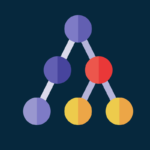In today’s world, data is everywhere. From online shopping habits to social media trends, businesses are awash in a sea of data. But how do companies make sense of all this information? That’s where association rule learning comes in. Association rule learning is a powerful technique that allows businesses to uncover patterns in data and make informed decisions. In this article, we’ll take a deep dive into association rule learning, exploring everything from the basics to real-world applications.
Understanding Association Rule Learning
Association rule learning is a popular data mining technique used by businesses to uncover patterns in large datasets. The goal of association rule learning is to find relationships between items in a dataset. By uncovering these relationships, businesses can make data-driven decisions that can lead to increased profits and better customer experiences.
For example, a company might use association rule learning to uncover relationships between products that are frequently purchased together. By uncovering these relationships, the company can create targeted marketing campaigns that encourage customers to purchase related products. This can lead to increased sales and customer satisfaction.
Definition and Basics
Association rule learning is a type of unsupervised learning. This means that the algorithm does not require a pre-existing set of labels to make decisions. Instead, the algorithm searches for patterns in the data and creates its own set of rules. The rules are based on the frequency of co-occurrence between items in a dataset. The stronger the relationship between two items, the higher the support and confidence values assigned to that rule.
Support and confidence are two key concepts in association rule learning. Support measures the frequency with which an itemset appears in the dataset. Confidence measures the conditional probability of finding item B given that item A is already present in a transaction. These values are used to determine the strength of the relationship between two items in a dataset.
Key Concepts and Terminology
To fully grasp association rule learning, you need to understand some key concepts and terminology. Here are a few terms to keep in mind:
- Itemset: A group of one or more items. In association rule learning, an itemset is a collection of items that appear together in a transaction.
- Support: The frequency with which an itemset appears in the dataset. Support is used to measure the popularity of an itemset in a dataset.
- Confidence: The conditional probability of finding item B given that item A is already present in a transaction. Confidence is used to measure the strength of the relationship between two items in a dataset.
- Antecedent: The item(s) that appear before the arrow in a rule. In other words, the antecedent is the itemset that leads to the consequent.
- Consequent: The item(s) that appear after the arrow in a rule. In other words, the consequent is the itemset that is predicted by the antecedent.
- Lift: Measures the strength of association between the antecedent and consequent. A lift value greater than 1 indicates a positive association between the antecedent and consequent, while a lift value less than 1 indicates a negative association.
Applications and Use Cases
Association rule learning has a wide range of applications in various industries. Some common use cases include:
- Market basket analysis: Analyzing customer purchase data to uncover relationships between products. This can help businesses create targeted marketing campaigns and improve their product offerings.
- Recommendation systems: Suggesting products or services based on a customer’s purchase history. This can lead to increased customer satisfaction and loyalty.
- Text mining: Finding patterns in unstructured text data. This can help businesses analyze customer feedback and improve their products and services.
- Predictive maintenance: Analyzing sensor data to predict when a machine might fail. This can help businesses prevent costly downtime and improve their operations.
Overall, association rule learning is a powerful data mining technique that can help businesses uncover valuable insights from their data. By understanding the key concepts and terminology associated with association rule learning, businesses can make informed decisions that can lead to increased profits, improved customer experiences, and more efficient operations.
The Apriori Algorithm
The Apriori algorithm is one of the most popular algorithms for association rule learning. It was first introduced by Rakesh Agrawal and Ramakrishnan Srikant in 1994. The Apriori algorithm works by iteratively scanning a dataset and creating a set of candidate itemsets. The candidate itemsets are then pruned based on their support values.

How the Apriori Algorithm Works
The Apriori algorithm works in three main steps:
- Find all itemsets that meet the minimum support threshold
- Create candidate itemsets by combining frequent itemsets
- Prune the candidate itemsets based on their support values
By iterating through these three steps, the Apriori algorithm gradually builds up a set of rules that describe the relationships between items in the dataset.
Advantages and Limitations
The Apriori algorithm is simple and easy to understand. It is also highly scalable, making it a good choice for large datasets. However, the Apriori algorithm can be slow when dealing with very large datasets. Additionally, the algorithm may produce a large number of rules, some of which may be spurious or irrelevant. As a result, it is important to carefully evaluate the results of an Apriori analysis.
Real-World Examples
The Apriori algorithm has been used in a wide range of industries, including:
- Retail: Analyzing purchase data to identify customer shopping habits
- Healthcare: Identifying patterns in medical data to improve patient outcomes
- Manufacturing: Analyzing sensor data to improve product quality
The Eclat Algorithm
The Eclat algorithm is another popular algorithm for association rule learning. Eclat stands for Equivalence Class Transformation. The Eclat algorithm works by generating a vertical representation of the dataset and using intersection to combine frequent itemsets.

Understanding the Eclat Algorithm
The Eclat algorithm works in two main steps:
- Create a vertical representation of the dataset
- Intersect the vertical representations of frequent itemsets
The Eclat algorithm is highly efficient and can handle large datasets. However, unlike the Apriori algorithm, the Eclat algorithm cannot handle datasets with missing values.
Benefits and Drawbacks
The Eclat algorithm is highly efficient and can handle large datasets. Additionally, the algorithm is easy to implement and can be run on a single machine. However, the Eclat algorithm requires all items in the dataset to be binary, and cannot handle datasets with missing values.
Practical Implementations
The Eclat algorithm has been used in a variety of real-world applications, including:
- Marketing: Analyzing purchase data to identify customer preferences
- Healthcare: Identifying patterns in medical data to improve patient outcomes
- Web mining: Analyzing web log data to improve website recommendations
The FP-Growth Algorithm
The FP-Growth algorithm is a popular algorithm for association rule learning. The algorithm was introduced by Jiawei Han, Jian Pei, and Yiwen Yin in 2000. The FP-Growth algorithm works by building a compact data structure called an FP-tree.

Exploring the FP-Growth Algorithm
The FP-Growth algorithm works in two main steps:
- Build an FP-tree from the dataset
- Mine the FP-tree to generate frequent itemsets
The FP-Growth algorithm is highly efficient and can handle large datasets. Additionally, the algorithm can handle datasets with missing values.
Pros and Cons
The FP-Growth algorithm is highly efficient and can handle large datasets. Additionally, the algorithm can handle datasets with missing values. However, the FP-Growth algorithm can produce a large number of rules, some of which may be irrelevant or spurious. Additionally, the algorithm may require extensive pre-processing to reduce the size of the dataset.
Successful Applications
The FP-Growth algorithm has been used in a variety of real-world applications, including:
- Retail: Analyzing customer purchase data to improve sales
- Healthcare: Analyzing patient data to improve diagnoses
- Social media: Analyzing user data to improve personalized recommendations
Conclusion
Association rule learning is a powerful technique that allows businesses to uncover patterns in data and make informed decisions. Whether you’re analyzing customer purchase data or trying to predict machine failures, association rule learning can help you uncover valuable insights. By understanding the basics of association rule learning and the different algorithms available, you can take advantage of this powerful technique and unlock the power of your data.



